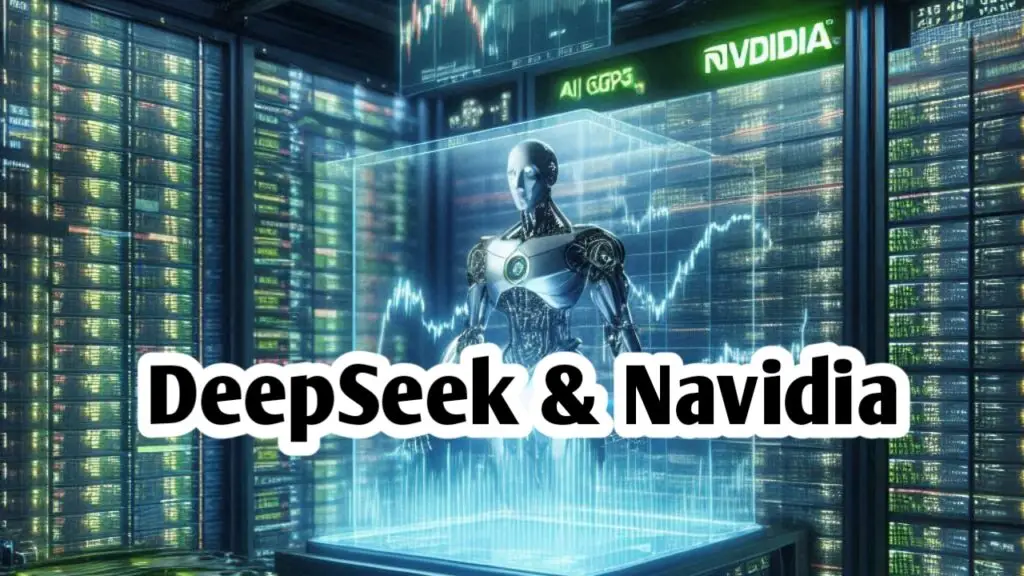DeepSeek’s efficient AI model challenges Nvidia’s dominance in AI chip demand. Will it disrupt the market or drive more innovation? Find out here.
DeepSeek’s Rise: A Challenge to Nvidia’s AI Dominance?
Nvidia has been the biggest winner in the AI revolution, with its advanced chips powering the industry’s growth. However, the emergence of DeepSeek, a Chinese AI startup, has raised new concerns about the sustainability of Nvidia’s market dominance.
The AI boom has driven Nvidia’s profit past $63 billion in the last four quarters, with its stock surging 800% since 2022. However, after DeepSeek’s rise was highlighted over the weekend, Nvidia’s shares plunged 17% on Monday before stabilizing with an 8.9% gain on Tuesday, closing at $128.99.

Why Is DeepSeek a Threat to Nvidia?
DeepSeek has developed a low-cost AI model, “R1,” that rivals some of the world’s most advanced AI models—reportedly using far fewer Nvidia chips. This innovation challenges the traditional AI development process, which has heavily relied on Nvidia’s powerful GPUs for training large-scale models.
- Tech Giants Developing Their Own Chips: Companies like Amazon, Google, and Microsoft are already designing their own AI chips to reduce reliance on Nvidia.
- Rival Chipmakers Gaining Ground: Intel and AMD are also pushing AI-specific chips to compete with Nvidia’s dominance.
The concern for investors is whether DeepSeek’s more efficient AI approach could reduce the demand for Nvidia’s high-end AI chips.
Could DeepSeek Actually Benefit Nvidia?
Despite concerns, some experts believe DeepSeek’s efficiency could actually increase overall demand for AI computing power—ultimately benefiting Nvidia.
- Inference vs. Training: DeepSeek’s model focuses on making AI inference cheaper and more efficient, which could lead to higher usage of AI applications. Nvidia has already stated that 40% of its data-center revenue comes from AI inference rather than training.
- Jevons Paradox: A well-known economic theory suggests that when technology improves efficiency, consumption actually increases. If AI becomes more accessible due to DeepSeek, demand for Nvidia’s chips might rise rather than fall.
- Computing Power Still Needed: DeepSeek’s R1 model still requires significant computing power, particularly for producing complex, multi-step responses.
U.S.-China Tensions & Nvidia’s China Business
DeepSeek’s success could also impact U.S. export controls on AI chip sales to China.
- Nvidia’s China Sales: Morgan Stanley analysts estimate that Nvidia sold over $10 billion worth of chips to China in the past year, despite U.S. restrictions.
- Stricter Regulations Possible: With DeepSeek’s rise, the U.S. may tighten export controls further, potentially pushing China to develop its own advanced AI chips faster.
Some U.S. AI industry leaders suspect that Chinese researchers may have stockpiled Nvidia’s most advanced chips before the restrictions or used workarounds such as cloud-based AI computing outside China.
The Future of AI: Is Nvidia at Risk?
Despite DeepSeek’s breakthrough, Nvidia’s long-term position remains strong:
- Big Tech AI Spending is Growing:
- Meta plans to spend $65 billion on AI and data centers in 2025, a 70% increase.
- Microsoft will invest $80 billion in AI infrastructure by June 2025.
- The U.S. government and tech leaders have pledged $500 billion for AI infrastructure to keep America ahead in AI.
- DeepSeek’s Scalability Issues: DeepSeek has struggled to deliver AI services at a global scale, which still requires Nvidia’s computing power.
- Market Demand for AI is Still Growing: Even if AI development shifts towards efficiency, demand for Nvidia’s chips is unlikely to disappear.
Conclusion: DeepSeek’s AI model is a wake-up call for Nvidia and the broader AI industry. While it introduces new challenges, it also highlights AI’s growing importance and could ultimately fuel greater demand for computing power.
FAQs
Q1: Why did Nvidia’s stock drop after DeepSeek’s AI announcement?
A: Investors feared that DeepSeek’s efficient AI model could reduce the demand for Nvidia’s expensive AI chips, which are currently essential for training advanced models.
Q2: Can DeepSeek completely replace Nvidia’s AI chips?
A: No, DeepSeek’s model still requires significant computing power for inference. Nvidia remains dominant in AI hardware.
Q3: Will U.S. impose stricter AI chip export controls on China?
A: Possibly. The U.S. has already restricted AI chip sales to China, and DeepSeek’s success could prompt even tighter regulations.
| Platform | Link |
|---|---|
| Website | Visit Website |
| YouTube | Visit YouTube |
| Visit Instagram | |
| Visit Facebook | |
| Telegram | Join Telegram |
| Join WhatsApp Channel |
- Crypto Market: Fed Cut, Regulation, Price Outlook
- Fed Rate Cut: Bitcoin’s Price Reaction
- Fed Rate Cut: Crypto Market Impact & Future
- Crypto Market Volatility & Institutional Adoption
- Crypto Market Outlook: Challenges and Opportunities